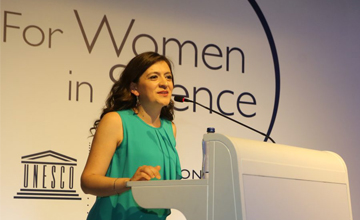
Assoc. Prof. Zeynep Çulfaz Emecen
She graduated from METU Department of Chemical Engineering in 2003. After completing her MS degree in the same department in 2005, she went to Holland, Twente University for her PhD studies. She completed her Ph.D. study on microdenier hollow fiber membranes and microelements in 2010. Since 2011, she has been a faculty member at METU Department of Chemical Engineering. Her research on membrane separation processes are mainly focused on the development of solvent-resistant membranes, the prevention of membrane contamination and the application of membranes as alternative separations in various production processes.
This year, the UNESCO-L'oreal Award for Support to Young Women in Science was awarded to Assoc. Prof. Zeynep Çulfaz Emecen due to her project proposal on "solvent-resistant cellulose nanocomposite membranes". Pointing out that the cellulose membranes that are currently being developed aim to further improve the separation performance, Dr. Çulfaz Emecen says that "chemical separation processes" are required to bring the entire chemical production process to the desired purity of the raw material found in the nature or of the product produced, and these processes typically constitute more than half of the cost of production. In this respect, the development of new and efficient separation processes using less energy and side chemicals is of great importance. "Traditional separation processes such as distillation and extraction have been used for centuries. However, these processes involve the use of significant amounts of energy or side-effects, which, in turn, has a high cost. The membranes that we can define as selective-permeable membranes offer an alternative to traditional separation processes, especially over the last 50-60 years. The basic principle of the membrane separation process is that decomposition occurs as the components transiting from one side of the membrane to the other side can move at different speeds in the membrane with the aid of a propulsive force such as pressure, concentration or voltage. Membrane technologies have the potential to carry out the same sorting operations without using side chemicals with much less energy than traditional separations in this way. " The most common use of membranes today is dialysis units used by patients with renal insufficiency, Çulfaz Emecen said. "Besides, we see more and more membranes in water treatment, separation of gas mixtures, biotechnology and food industry. However, they are very rarely used in environments where there are solvents other than water. The main reason for this is that there are very few membranes resistant to such solvents on the market. On the other hand, membranes have potential areas of use in many areas, including mainly refineries, petrochemicals, pharmaceuticals and food industries."
Stating that they aimed to develop solvent-resistant membranes from cellulose, a natural polymer found on the cell wall of plants in their research supported by L'Oréal-UNESCO For Women in Science Scholarship, Çulfaz Emecen says that cellulose is an advantageous material for such applications in that it is abundant in nature and does not dissolve in standard molecular solvents, and added the cellulosic membranes they have developed so far are resistant to many solvents and that they can distinguish the model organic molecules they use among these solvents to a certain extent. Assoc. Prof. Zeynep Çulfaz Emecen concluded her words as follows: "In this project, we think that we can further improve the degree of separation with 'all cellulose nanocomposite' membranes, which have cellulosic nanocrystals in the cellulose domains in the amorphous structure. The phase inversion method we use in the production of membranes allows the production of membranes in both film and hollow fiber form. Now, we can produce membranes in both types in our research lab. We think that the production of hollow fiber membranes is a process that can be easily scaled up and therefore, the transition to application in the process of mass production and separation of the membranes we are aiming to develop can be carried out easily.

